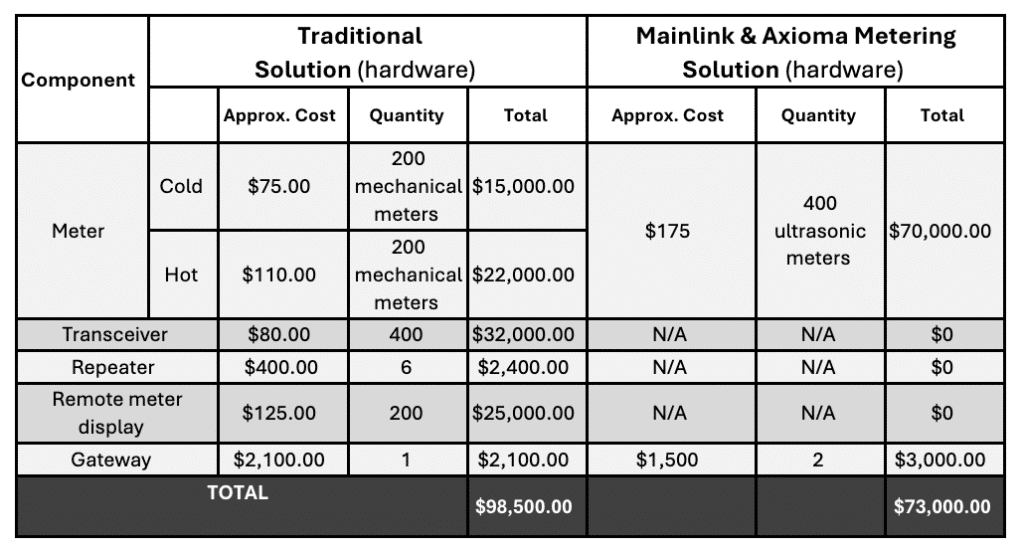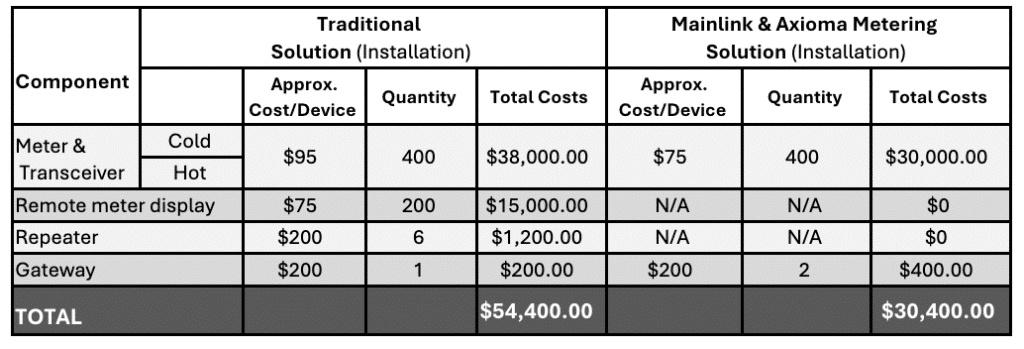How to Save $50,000 on Water Metering Infrastructure in a 200-Unit Building

Do You Have to Have a Smart Water Meter?
2025-09-29
Forget Remote Meter Displays — Cut $200 Per Unit and Stay NTEP-Compliant
2025-09-30Traditional metering systems may technically get the job done but they come with invisible losses that add up fast. Whether it’s excess hardware, inflated labor, wasted water, or tenant billing disputes – traditional submetering ends up costing more while delivering less reliability and accuracy for the future.
Let’s put the assumptions aside and look at the real numbers. Below is a cost comparison based on an example of a 200-unit multifamily project in California, modeled to reflect traditional and advanced system configurations.
What Legacy Systems Require
Legacy systems are commonly used in multifamily properties to collect water usage data without manual meter reads. They rely on short-range radio frequency to transmit consumption data. But beneath the surface, they require multiple layers of hardware, such as:
- Transceiver – sends data from mechanical meters
- Repeater – boosts RF signal range
- Remote Display – provides visible usage data per unit
- Gateway – collects and transmits data
All this hardware just to get data from mechanical meters to the system.
Hardware Price Comparison: Traditional vs. Smart Submetering for a 200-unit multifamily building*
This isn’t just a cost comparison — it’s also a technological comparison. Traditional solutions rely on mechanical meters, which are about five times less accurate than ultrasonic meters and require multiple hardware components. In contrast, smart submetering solutions use advanced ultrasonic meters and eliminate unnecessary equipment. And here’s the surprising part: the more powerful, more advanced option now costs less — and delivers far more value.
In our example, the traditional solution totals to approximately $98,5000, while the ultrasonic meter solution for the same project adds up to around $73,000.
Ultrasonic meters have no moving parts, offer a 16-year battery life, maintain consistent accuracy, and enable real-time leak detection. They don’t only require additional hardware, as shown in the table — they upgrade your infrastructure to last longer, conserve water, and reduce long-term costs.

*Costs are approximated for the U.S., CA market and may vary by region and project conditions.
Traditional vs. Smart Submetering Installation Costs for a 200-Unit Apartment Building – Costs Grow with Every Extra Component
Labor costs also have an impact on overall solution implementation. Installation time varies by state, technician price rates, property complexity, and other factors. But one thing is always true: the more parts your system requires, the more time it takes to install it and the more it costs. Smart and advanced systems install faster, with fewer delays and less coordination. See the comparison table of installation costs between traditional mechanical and Mainlink & Axioma smart solutions. With a traditional setup, your installation expenses could reach $54,400. With a streamlined advanced solution, they can be closer to $30,400.

Note: Labor costs vary by region and building type. This calculation is based on U.S. California price estimates.
The Maintenance You Don’t See — Until You’re Paying for It
Legacy systems continue to generate costs long after installation. Mechanical meters typically degrade within 5 to 10 years. Since they rely on moving parts like valves and turbines, their accuracy declines over time due to debris buildup and internal wear. Even with regular maintenance, replacements over a 10-year period are inevitable.
Remote displays and transceivers also require ongoing upkeep. Batteries usually need to be replaced every 10 years, assuming no early failures, wiring issues, or delays in accessing units. These are not one-time expenses. They recur quietly, eating into your margins year after year.
By contrast, ultrasonic smart meters are built for long-term reliability and accuracy. With no moving parts, a 16-year battery life, and no need for transceivers or remote displays, they eliminate much of the maintenance burden and the costs that come with it.
Submetering for Owners Who Want Lower Costs — and Future-Proof Infrastructure
Modern submetering is more than a system upgrade. It’s a shift toward advanced, leaner operations. It removes unnecessary hardware. It stops tenant complaints about unfair billing. It detects leaks before they cost you thousands. It brings effectiveness in business operations and peace of mind using future-proof technology for property management.
Mainlink’s advanced smart submetering solution includes:
- NTEP-certified ultrasonic meters compliant with regulations
- A single gateway per property — no transceivers, no repeaters
- An NTEP-certified mobile app for residents (replaces remote meter displays)
- A Head-End system for monitoring property water usage
It’s efficient. Scalable. And built to pay for itself — fast.
Conclusion
In the case of a 200-unit multifamily property project in California, our estimates show that property owners using traditional systems would spend approximately $98,500 on hardware alone. By comparison, with Mainlink’s and Axioma Metering’s smart ultrasonic solution, hardware costs come in at $73,000 — saving roughly $25,500 in hardware expenses only.
Because traditional systems require more components, installation costs climb up as well — approximately $54,400 versus $30,400 for the ultrasonic setup. That’s another $24,000 saved in labor and deployment costs.
Total estimated savings – $49,500; excluding long-term maintenance.
Unlike mechanical meters, which degrade in performance over time due to internal wear and debris buildup, ultrasonic meters have no moving parts. That means consistent accuracy, less downtime, and no need for mid-life replacement. With built-in leak detection and real-time alerts, you can catch and resolve issues before they become costly. And with precise, per-unit billing, you gain transparency — and trust — with residents.
Curious how these numbers would look for your property?
Whether your building is larger or older than the one we used in our example – or located in a different state — we’ll help you assess the full picture. Let’s run the numbers together — book a quick call. Or meet us in person at the Apartmentalize exhibition, June 12–13.

